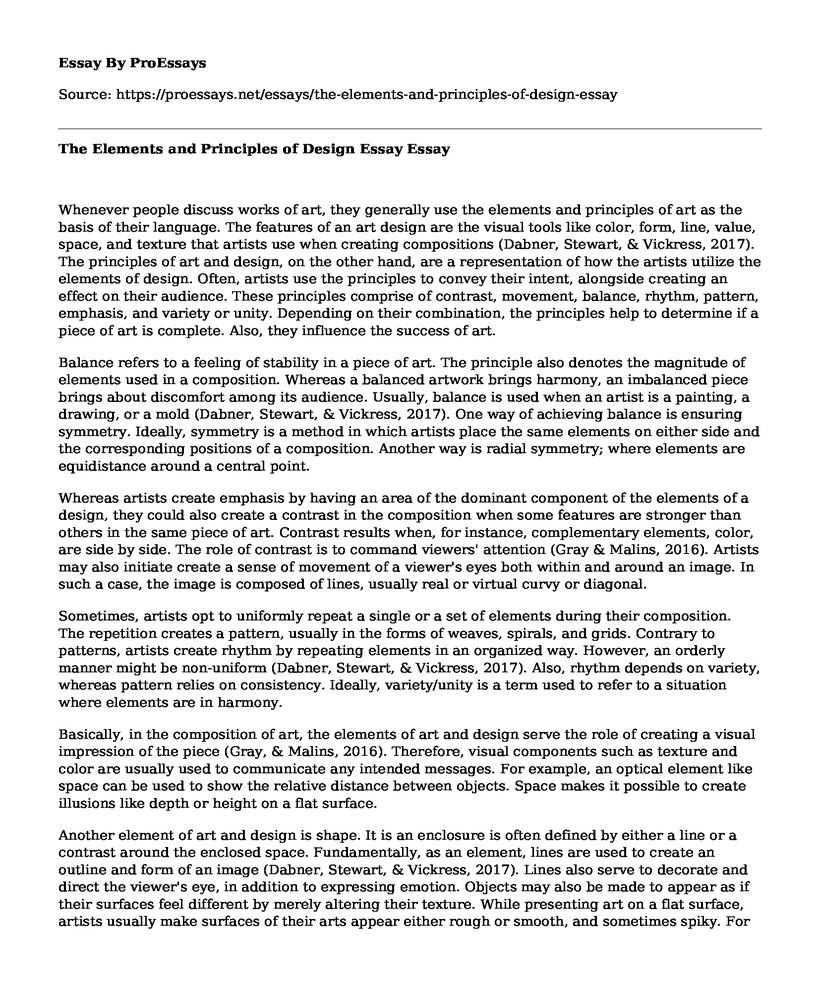Whenever people discuss works of art, they generally use the elements and principles of art as the basis of their language. The features of an art design are the visual tools like color, form, line, value, space, and texture that artists use when creating compositions (Dabner, Stewart, & Vickress, 2017). The principles of art and design, on the other hand, are a representation of how the artists utilize the elements of design. Often, artists use the principles to convey their intent, alongside creating an effect on their audience. These principles comprise of contrast, movement, balance, rhythm, pattern, emphasis, and variety or unity. Depending on their combination, the principles help to determine if a piece of art is complete. Also, they influence the success of art.
Balance refers to a feeling of stability in a piece of art. The principle also denotes the magnitude of elements used in a composition. Whereas a balanced artwork brings harmony, an imbalanced piece brings about discomfort among its audience. Usually, balance is used when an artist is a painting, a drawing, or a mold (Dabner, Stewart, & Vickress, 2017). One way of achieving balance is ensuring symmetry. Ideally, symmetry is a method in which artists place the same elements on either side and the corresponding positions of a composition. Another way is radial symmetry; where elements are equidistance around a central point.
Whereas artists create emphasis by having an area of the dominant component of the elements of a design, they could also create a contrast in the composition when some features are stronger than others in the same piece of art. Contrast results when, for instance, complementary elements, color, are side by side. The role of contrast is to command viewers' attention (Gray & Malins, 2016). Artists may also initiate create a sense of movement of a viewer's eyes both within and around an image. In such a case, the image is composed of lines, usually real or virtual curvy or diagonal.
Sometimes, artists opt to uniformly repeat a single or a set of elements during their composition. The repetition creates a pattern, usually in the forms of weaves, spirals, and grids. Contrary to patterns, artists create rhythm by repeating elements in an organized way. However, an orderly manner might be non-uniform (Dabner, Stewart, & Vickress, 2017). Also, rhythm depends on variety, whereas pattern relies on consistency. Ideally, variety/unity is a term used to refer to a situation where elements are in harmony.
Basically, in the composition of art, the elements of art and design serve the role of creating a visual impression of the piece (Gray, & Malins, 2016). Therefore, visual components such as texture and color are usually used to communicate any intended messages. For example, an optical element like space can be used to show the relative distance between objects. Space makes it possible to create illusions like depth or height on a flat surface.
Another element of art and design is shape. It is an enclosure is often defined by either a line or a contrast around the enclosed space. Fundamentally, as an element, lines are used to create an outline and form of an image (Dabner, Stewart, & Vickress, 2017). Lines also serve to decorate and direct the viewer's eye, in addition to expressing emotion. Objects may also be made to appear as if their surfaces feel different by merely altering their texture. While presenting art on a flat surface, artists usually make surfaces of their arts appear either rough or smooth, and sometimes spiky. For objects casting shadows, artists typically focus on how dark or light the object is. For example, the side of the object facing light is usually shaded lighter, irrespective of its color. A choice of the principles of art and design to observe and the elements to utilize depends on an artist's life experience, culture, and the history behind such a piece of art.
References
Dabner, D., Stewart, S., & Vickress, A. (2017). Graphic Design School: The Principles and Practice of Graphic Design. John Wiley & Sons.
Gray, C., & Malins, J. (2016). Visualizing Research: A Guide to the Research Process in Art and Design. Routledge.
Cite this page
The Elements and Principles of Design Essay. (2022, Mar 07). Retrieved from https://proessays.net/essays/the-elements-and-principles-of-design-essay
If you are the original author of this essay and no longer wish to have it published on the ProEssays website, please click below to request its removal:
- Piper - Pixar Movie Review
- Choreographic Music Videos
- The Big Short and No Impact Man Films Analysis Essay
- Essay Sample on Pre-Colonial Art: Asian vs African Expression
- Essay Sample on Polanski's Knife in the Water: Minimalism in a Dangerous Atmosphere
- Teens and Social Media: Benefits and Challenges - Essay Sample
- Essay Example on Long Takes in Filmmaking: From Theatrical to Cinematic







